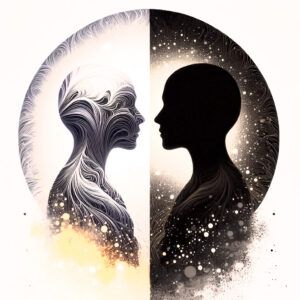
CONCEPT:
Nāṭya Śāstra
Pronunciation:
/ˈnɑːtjə ˈʃɑːstrə/
Definition:
The Nāṭya Śāstra is an ancient Indian treatise on performing arts, encompassing dance, drama, music, and stagecraft. Attributed to the sage Bharata Muni, it is considered the foundational text for Indian classical performing arts and provides detailed guidelines for actors, dancers, musicians, and costume designers.
Other Concepts
Deeper Understanding
The Nāṭya Śāstra stands as one of the most comprehensive and significant texts in the realm of Indian classical performing arts. Attributed to the sage Bharata Muni, this ancient treatise is believed to have been composed between 200 BCE and 200 CE. Its breadth and depth cover the intricacies of dance, drama, music, and stagecraft, making it an essential reference for practitioners and scholars alike.
While the Nāṭya Śāstra functions as a technical manual, its scope extends far beyond mere instruction. It delves into the philosophical underpinnings of the arts, exploring the nature of human experience and the transformative power of artistic expression. Central to the Nāṭya Śāstra is the concept of rasa, or aesthetic essence, which is the emotional experience evoked in the audience through performance. The treatise identifies nine rasas: Śṛṅgāra (love/beauty), Hāsya (laughter/comedy), Karuṇa (compassion/pathos), Raudra (anger/fury), Vīra (heroism/courage), Bhayānaka (fear/terror), Bībhatsa (disgust/repulsion), Adbhuta (wonder/amazement), and Śānta (peace/tranquility).
The text’s detailed guidelines cover various aspects of the performing arts. For actors and dancers, it outlines the principles of abhinaya (expression), which include physical gestures, facial expressions, and body movements. Musicians find in the Nāṭya Śāstra classifications of instruments and the foundational elements of Indian classical music. The treatise also addresses stagecraft, offering insights into the design and construction of performance spaces, lighting, and costume design.
Historically, the Nāṭya Śāstra’s influence has been profound and enduring. Its comprehensive approach to the arts has shaped the development of various forms of Indian classical dance, theater, and music. Despite its ancient origins, the principles articulated in the Nāṭya Śāstra resonate with contemporary understandings of psychology and aesthetics. Modern research in these fields often echoes the treatise’s insights into human emotions and the psychological impact of artistic expression.
The Nāṭya Śāstra remains a vibrant and relevant text within the Indian cultural landscape. It continues to inspire and inform artists and scholars, offering a rich tapestry of knowledge that bridges the ancient and the modern. Its enduring legacy is a testament to the timeless nature of its teachings and the universal appeal of its exploration of the human condition through art.
In summary, the Nāṭya Śāstra is not merely a historical document but a living text that continues to shape and enrich the practice and understanding of Indian performing arts. Its comprehensive coverage of dance, drama, music, and stagecraft, combined with its deep philosophical insights, make it an invaluable resource for anyone engaged in the study or practice of the arts.
References
Bharata Muni. Nāṭya Śāstra. Translated by Manomohan Ghosh, Asiatic Society of Bengal, 1951.
Brown, Sarah, et al. “The neural basis of human dance.” Cerebral Cortex, vol. 16, no. 8, 2006, pp. 1157-1167.
Schechner, Richard. Performance Theory. Routledge, 2003.

